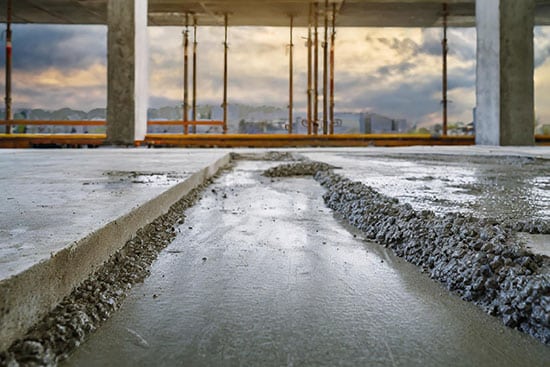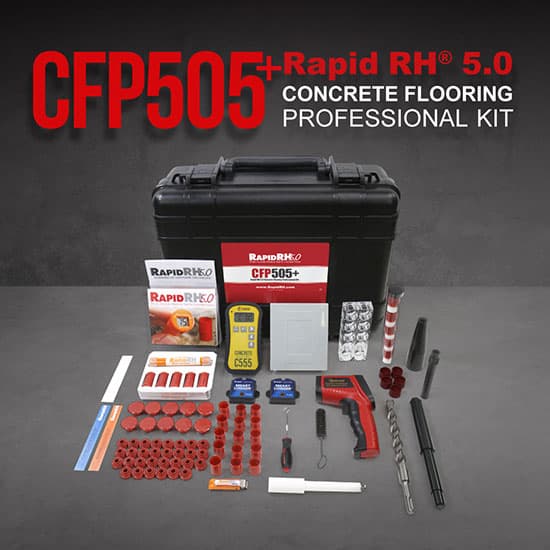How Moisture Impacts Floor Coverings Over Concrete

If not dried properly, concrete can cause a multitude of problems for a floor covering
Imagine walking down the aisle of a flooring store with your customer, showing them all the possibilities for their home. Glistening hardwoods, cozy carpets, regal tile…
But this customer has a concrete subfloor. Could moisture in the concrete affect certain types of flooring installed over top? How?
That’s where this article comes in. In fact, concrete can affect a floor covering installed over top. And it has to do with moisture.
Let’s explore this topic with the following points:
- The basics of floor coverings and moisture
- Moisture’s impact on flooring systems
- Proper vapor retarders below the concrete
- Testing for moisture
- Tips and techniques to stop floor covering failures
The Basics of Floor Coverings and Moisture
Concrete is the base on which many types of floor coverings are placed. This includes ones like:
- Carpet
- Hardwood
- Engineered hardwood
- Laminate
- Vinyl
- Tile
Choosing your floor covering might be the fun part, but if the concrete isn’t dry or the flooring isn’t installed properly, you could be setting yourself up for failure.
This is because areas of the building or room that are prone to moisture could damage or destroy flooring in a matter of weeks or months. And there are many areas in a building where moisture tends to lurk, such as bathrooms, kitchens, and concrete floors.
Let’s take a look at how moisture can impact a floor in the context of concrete.
Moisture’s Impact on Flooring Systems
In short, moisture has the potential to damage an astonishing variety of flooring systems. Here’s what happens.
After concrete is poured, it goes through the curing process and then continues to dry. Usually, the drying process takes a month for every inch in thickness of concrete laid (in ideal drying conditions—enclosed and with the HVAC running). Then, a floor covering like hardwood, carpet, or tile is installed over top.
However, if the concrete hasn’t dried sufficiently before the floor covering is laid, there may be problems down the road. Moisture from deep in the concrete will continue to rise to the top, and depending on the flooring, that moisture will absorb into it or collect under it.
These two outcomes of moisture releasing from the concrete can cause quite a few problems in the flooring, including:
- Adhesive breakdown. Adhesive breakdown in flooring is caused by alkaline salts in the concrete. As moisture rises to the surface of the concrete, the alkaline salts that move with the moisture work their way between the concrete and the flooring. They break down the adhesive, causing the flooring to pop up. This is unsightly and can present a tripping hazard. It also compromises the integrity of the flooring. Bubbling or ripples in the floor covering are tell-tale signs that moisture has gathered in the flooring, pushing it up in that area.
- Warping or distortion. This is especially common with wood flooring, which is very susceptible to moisture. Wood absorbs moisture like a sponge, so the boards will easily twist, cup, bow, or crack in response.
- Mold and mildew. Two common problems in carpeting and tile, mold and mildew can grow under or in the flooring. They are caused by constant dampness from moisture being trapped under the flooring. If you start to smell a musty odor that won’t leave after cleaning or you see black spots on the floor, this is a sign of mold. It should be dealt with as soon as possible because it can cause illness.
- Staining or discoloration. White is a common stain color that appears on tile grouting or mosaic flooring. This is due to efflorescence: the salts in the concrete rise to the surface with the moisture and then get deposited there when the moisture evaporates. This residue can eat away at or otherwise damage the floor.
- Re-emulsification of the adhesive. Re-emulsification is when the adhesive gets soft again and doesn’t bind the floor covering to the concrete. Excessive moisture passing through the concrete can cause this.
As you may have noticed, these problems are all a result of moisture—and with it, alkaline salts—passing up through the concrete and into the adhesive or floor covering. One way to help prevent this is with a proper moisture retarder under the concrete.
Proper Vapor Retarders Under Concrete
A vapor retarder is a plastic material that sits underneath the concrete and is designed to block moisture from leaking into it. Vapor retarders don’t always block all the moisture though, which is why they are classed based on their permeability.
Permeability, expressed as perms, is a rating representing the ability of moisture to pass through the vapor retarder over a specified amount of time. The lower the perm rating, the less moisture is able to get through.
The vapor retarder itself should be at least 10 mils thick to avoid tearing, according to the Guide to Concrete Floor and Slab Construction published by the American Concrete Institute. If you’re working with a lot of sharp points, it may need to be even thicker. Once it tears, its ability to prevent moisture is compromised.
Even with the benefit of a vapor retarder, knowing how to minimize the effect of moisture on flooring systems is worthy knowledge.
Concrete Moisture Testing

The Rapid RH kit will help ensure your concrete has been dried properly before you install a floor covering
The biggest step in stopping flooring damage due to concrete moisture comes even before the installation of the flooring. This is the pre-testing of the concrete itself.
If the vapor retarder isn’t working properly, or the concrete is not truly dry yet, moisture will continue to rise to the surface of the concrete. This moisture will collect under or seep into the flooring over top, often severely damaging it.
The problem is, you usually can’t tell moisture is rising to the concrete’s surface just by looking at it. To see what’s really going on beneath the surface, you have to conduct a moisture test.
If you’re doing your testing with a concrete moisture meter, the easy-to-use Wagner Meters C555 is the most accurate one. All you have to do is scan the surface with the sensor pad on the bottom of the meter to get fast results.
However, you will want to check with the manufacturer of the floor covering, as a concrete meter does not meet ASTM standards. Make sure that the manufacturer will honor its warranty if you use a moisture meter. And if they do, check that you have the readings low enough per their specifications.
If you’re conducting an RH test, the Wagner Meters’ Rapid RH® testing provides a result in just 24 hours, though usually a reading accurate enough to make a business decision is available within a couple of hours.
The Rapid RH test involves drilling strategically placed holes in the concrete and inserting small in situ probes into them. The probes detect the moisture in the concrete. Used with the Wagner Meters’ DataGrabber® and the accompanying DataMaster™ L6 app, you can collect the readings from the Rapid RH test. Once collected, you can organize, analyze, and make reports of the data.
What’s more, with the True Remote Monitoring™ system, you don’t even have to be on the jobsite to collect the data.
This data can help you determine whether it’s safe to install flooring without the risk of ruining it or whether there’s too much moisture rising from the concrete to do so.
Tips and Techniques to Stop Floor Covering Failures
Here are some things to keep in mind before, during, and after installing a floor covering over concrete:
Choose Moisture-Resilient Flooring
Oak floors probably aren’t the best option in moisture-prone areas like bathrooms or kitchens because they absorb moisture so easily. Instead, select flooring types that are more resistant to leaking water. These are usually inorganic (synthetic) floors, such as tile (porcelain, ceramic, vinyl, etc.) or vinyl (luxury or sheet).
And if you’re installing flooring where spills happen but are cleaned up quickly, laminate and engineered hardwood can work.
Install Properly
Some types of flooring like laminate hardwood require a gap between the edge and the wall, and other types may require certain practices during installation. With any type of flooring, be sure to follow the manufacturers’ installation instructions.
Above all, check that the concrete is dry before installing the floor. You can do this with a concrete moisture meter or RH testing:
Rapid RH testing: If you’re preparing to install new flooring over concrete, use this indispensable tool to check the concrete’s moisture levels. Within just 24 hours, you’ll have the most reliable measurement of the concrete’s relative humidity, helping you decide if you can safely install flooring over top.
DataGrabber: This handy optional tool allows you to automatically collect data from the Rapid RH test when you are away from the job. It connects via Bluetooth to your smartphone, so you don’t have to manually collect the data yourself.
True Remote Monitoring: If you are using the Rapid RH, the True Remote Monitoring system will take it to the next level. This system allows you to be anywhere in the world and receive relative humidity readings of the concrete.
Perform Regular Maintenance
Installing the floor is only the beginning. Advise the owner to perform regular maintenance to ensure that the floor stays in peak condition and to stop any moisture problems that may rear their ugly heads. Here are some important tips:
- Sweep and/or mop floors regularly.
- Clean up spills or accidents immediately.
- After a heavy rain, check for leaks and excess moisture.
You may also want to include an advanced tool as part of your installation package to prevent unwanted problems down the road. That tool is Floor Sentry®, a small, embedded tool that monitors temperature and relative humidity conditions in flooring.
If the levels become too high, the floor is prone to damage, so Floor Sentry notifies your clients when the levels have reached that threshold, allowing them to take action before it’s too late.
Choose Wagner
Because concrete is made with water, moisture will always be a potential issue when you’re installing a floor covering over top. It can seep into the flooring and cause it to warp or separate. It can collect under the floor and cause mold or other structural damage.
Don’t wait until your floors are ruined!
By making sure the concrete is dry enough to install the floor covering and choosing moisture-resistant floors, you can minimize or eliminate these issues.
Make your proactive steps even easier with a Wagner Meters product to monitor or measure the moisture content. Contact us today for expert advice and assistance with concrete moisture testing.
Jason has 20+ years’ experience in sales and sales management in a spectrum of industries and has successfully launched a variety of products to the market, including the original Rapid RH® concrete moisture tests. He currently works with Wagner Meters as our Rapid RH® product sales manager.
Last updated on March 7th, 2025



